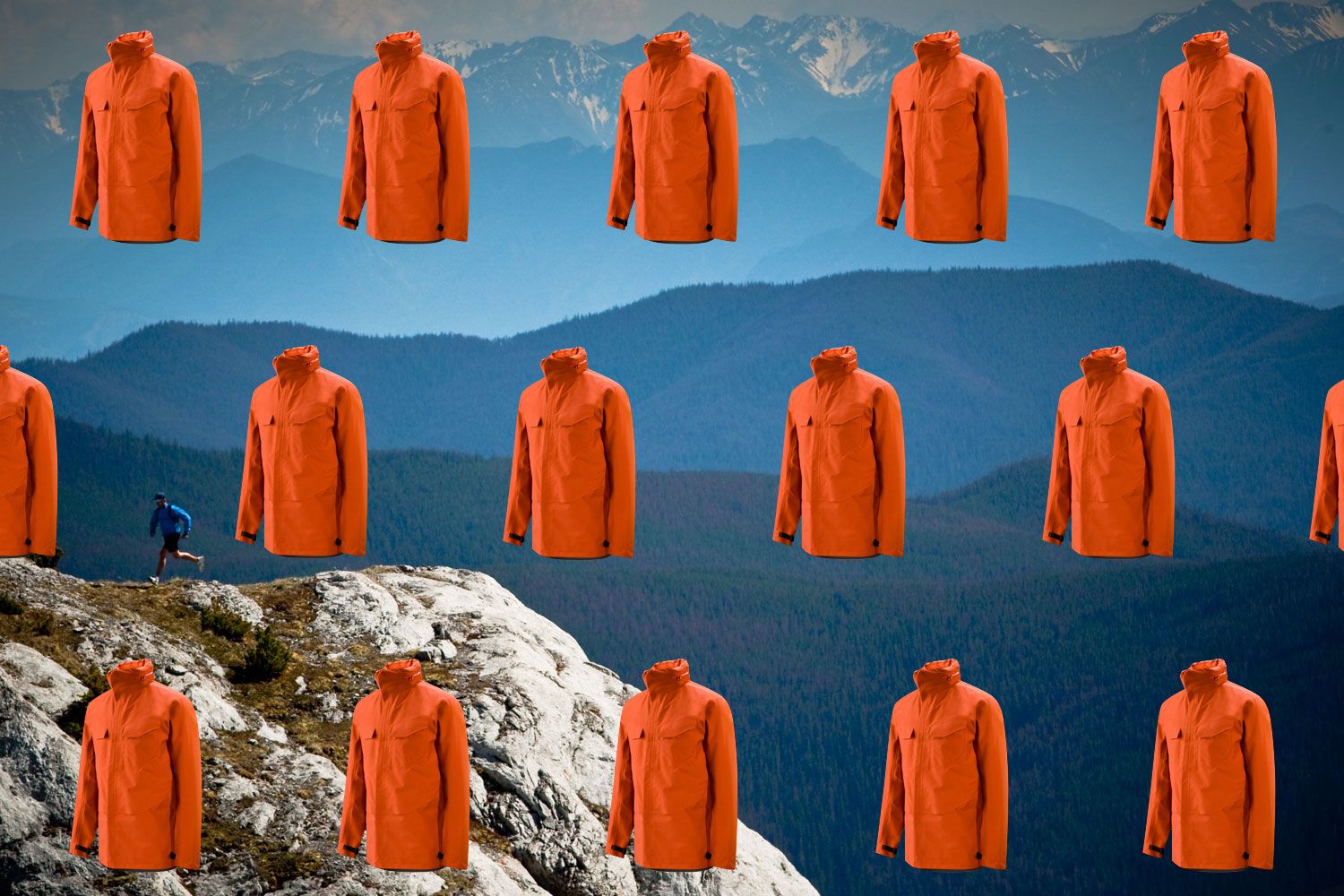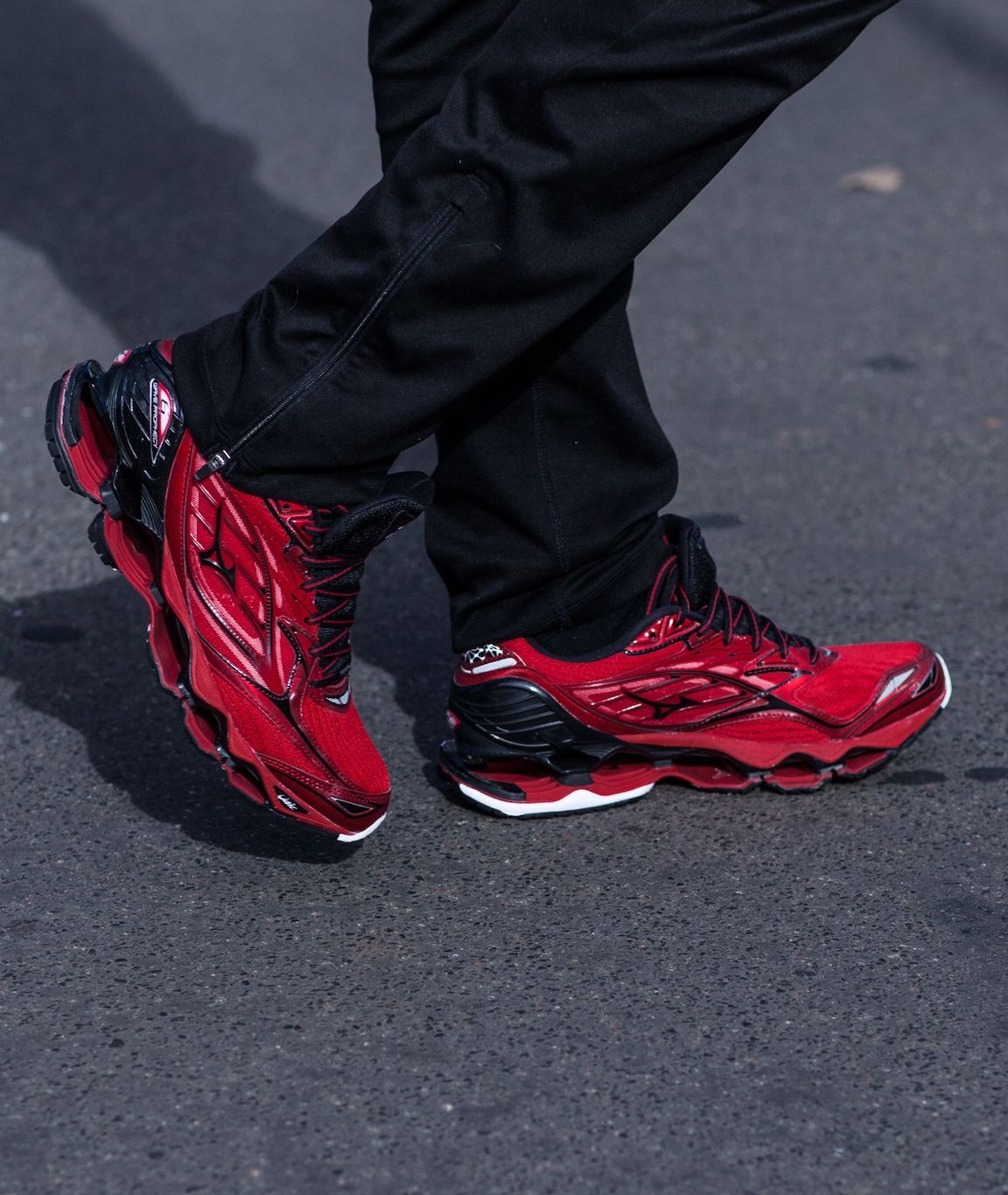Summer Tactics: NIK KOSMAS Pressure Tests Technical Apparel in the Heat
|Nik Kosmas
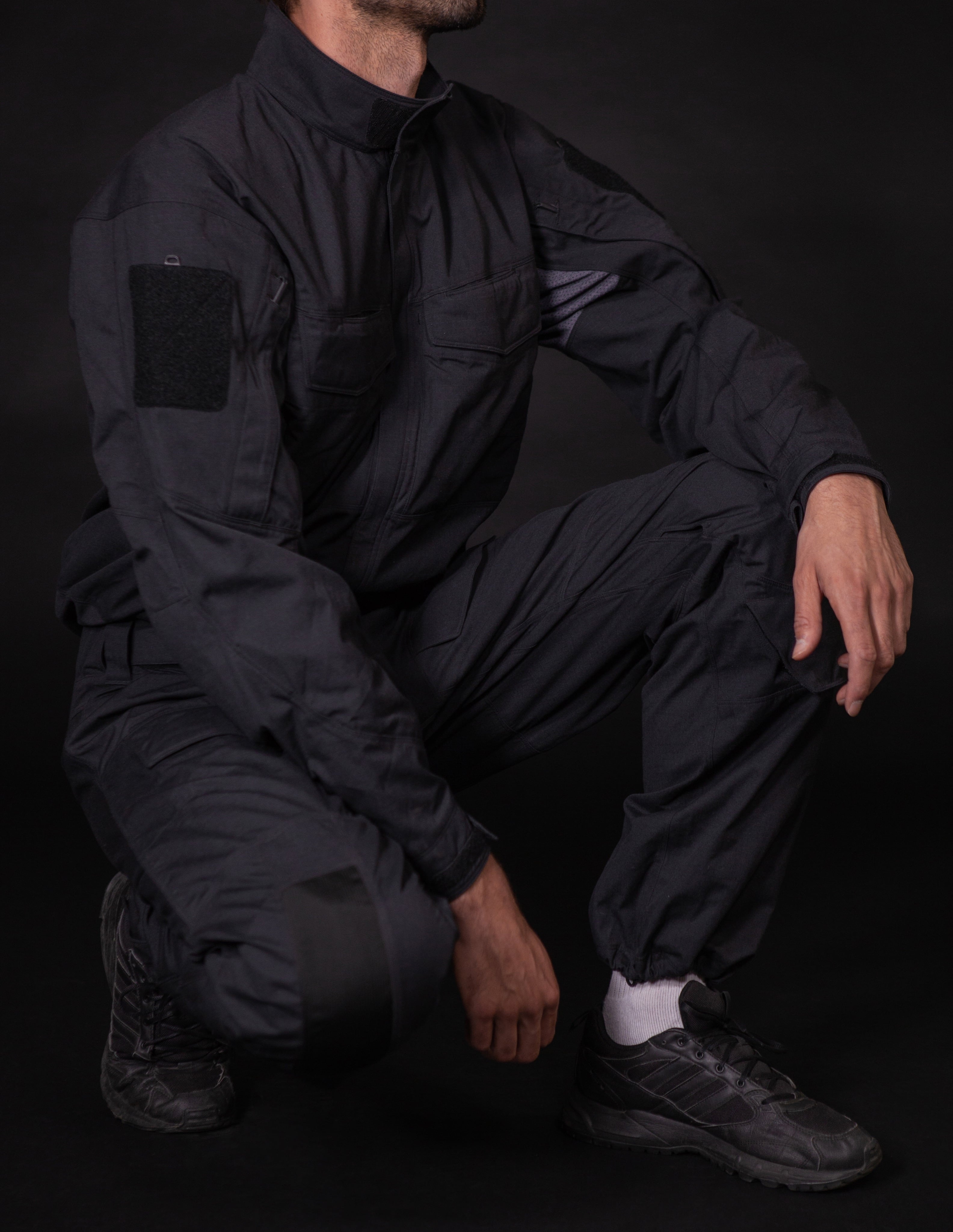
What are tactical and technical garments? What is their appeal? These are categories that span workwear, public safety, and military apparel, but also gear for mountaineering, motocross and skydiving. Garments come in shades of black, grey, green, sand, and camouflage. They differentiate themselves from sportswear – though it’s not always clear how. Many products are designed for use by military or law enforcement, yet today there is a clear trend toward technically inspired “high fashion” from brands such as Berlin’s GmbH and ACRNYM, and big labels such as Burberry and Dior. For tactical producers, there’s no need to update something unless a new material or construction serves its purpose better. New pieces are designated as parts of new “generations,” not seasons. Their ethos is one of technological evolution.
I present my review of the following products from Crye Precision, Arc’teryx, Lundhag, and 5.11 Tactical to encourage designers to sit down with engineers and materials scientists and make sure their designs work on the top-performing level. At the same time, I want big brands with resources to know that users like me are looking for creativity in their garments – not parody or Frankenstein pastiche. Design demands usually include factors such as strength-to-weight ratio, durability, freedom of movement, and ease of use. For these garments the evaluation is based on the ergonomics of the cut, the durability of the stitching, and quality of the fabrics: their lightness, their temperature regulation, how they deal with moisture, and so on. In many cases I find that when the craft is top-level, a strong aesthetic flows naturally as well.
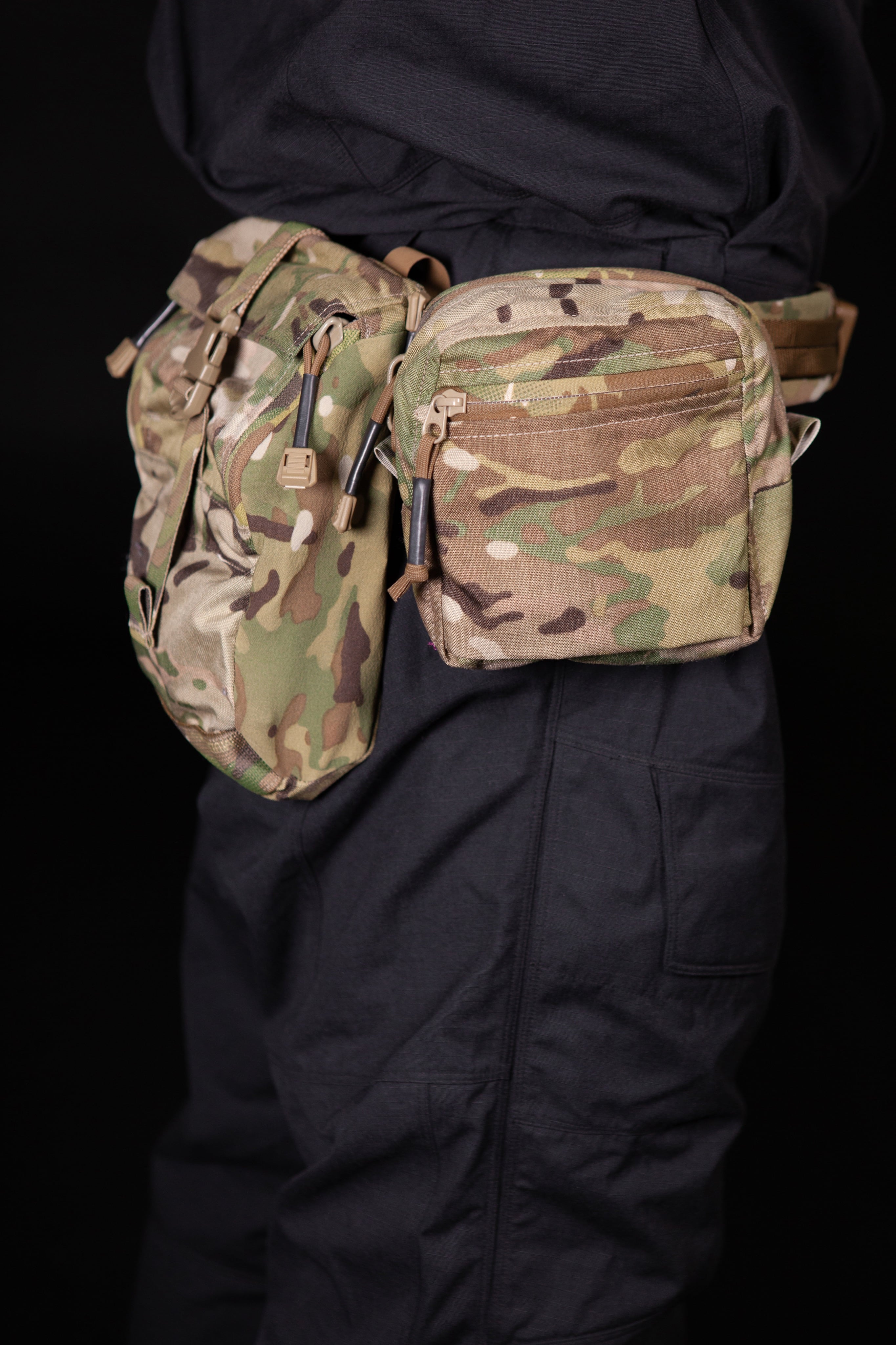
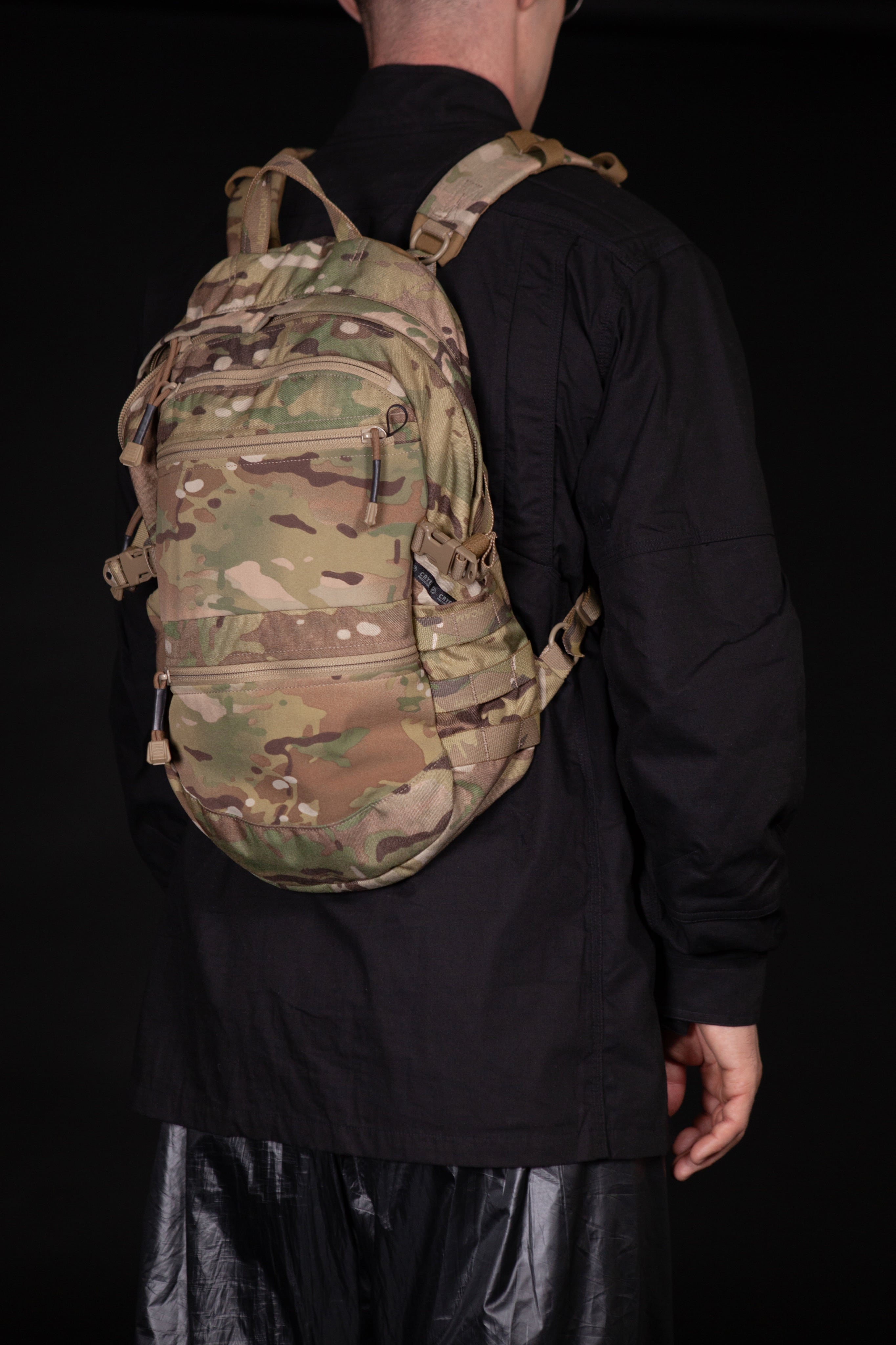
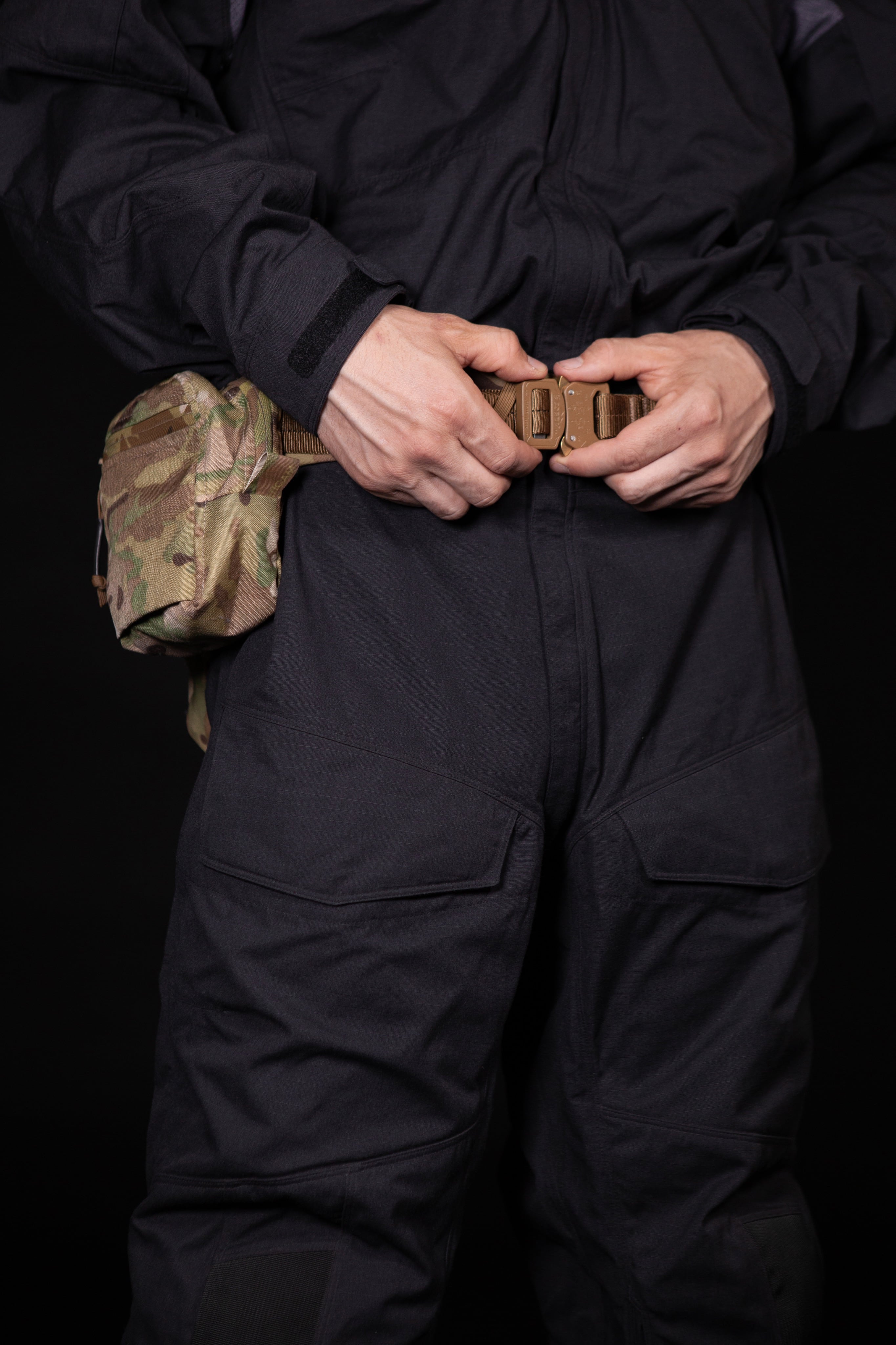
Crye Precision
Crye Precision was founded by two Cooper Union graduates who got their start with a bid to create a helmet with integrated communications for the US Army. Most governments require that the gear they supply to their troops be produced in their own country, or at least on the same continent, something also true for a lot of high-quality workwear. (For example, the brand Camber, which makes heavy cotton t-shirts sold wholesale for athletic, school, and industrial use, is made in the United States.) This means much of the Vancouver-based brand Arc’teryx’s stuff is made in Canada, and Crye equipment is made in Brooklyn, NYC. The first time I tried to get my hands on some Crye gear, my contact there basically told me that they give zero fucks about being reviewed. This is hardcore gear for a serious application and user group. Somehow this time I got lucky, and was able to get several pouches, a belt, and a backpack.
AVS™ 1000 PACK
The AVS™ 1000 PACK has five different configurations. It can be combined with body armor or rigged with conventional backpack straps for everyday use. It took me about half an hour to figure out how to rig the backpack straps together, however. Most backpacks that I have really put to work seem to fail in the strap department: straps get the most wear and tear, and the Crye design is such that there isn’t any pulling on a sewn seam. Instead, it uses a combination of Velcro, webbing, and plastic hardware to connect the straps to the body. The fit is slim and streamlined, the hardware lightweight and efficient.
GP POUCH 6X6X3 SPS-070 and GP POUCH 9x7x3 SPS-069
The GP POUCH 6X6X3 SPS-070 is simple, small, and very well designed. For a civilian it’s the perfect side pouch. The zip-pulls are convenient and the material it’s constructed from is clearly durable. The product has the aesthetic appeal that comes from excellent material sourcing, as even the zippers are in the brand’s MultiCam camouflage pattern. The teeth of the zippers are also plastic, which makes it that bit lighter. The backside supports the pouch being attached to other carriage systems or to a belt. The stitching is clean. It’s funny how something so small and simple can still express its quality and attention to detail.
Because it is bigger, the GP POUCH 9x7x3 SPS-069 perhaps has fewer applications for a civilian. It has the same loving attention to detail as all the other products I saw from Crye. The pouch lays down pretty flat but can expand to hold quite a bit of gear. It secures closed with a buckle but also has a cool flip-open top, combined with two lateral zippers that can all be opened to expand to hold an even bigger item inside. (The Crye website cites the following examples: 12 shotgun shells, a radio, a hand grenade, water.)
RANGE BELT™ MRB-IB2
The RANGE BELT™ MRB-IB2 belt is the lightest and lowest profile belt offered by Crye. An operator’s belt does a lot more than hold up pants: it’s a key tool for rigging together all the kit a soldier has to carry. The belt feels strong and is light and easy to wear. It can be worn above pants or serve as a normal belt. It has a high-quality quick release AustriAlpin COBRA® buckle, which costs around $25 to purchase on its own. I could imagine myself neurotically closing and opening this belt, addicted to the smooth and solid feeling of the buckle doing its thing. It has a material on the inside, similar to Velcro, which stops the belt from sliding around on the body.
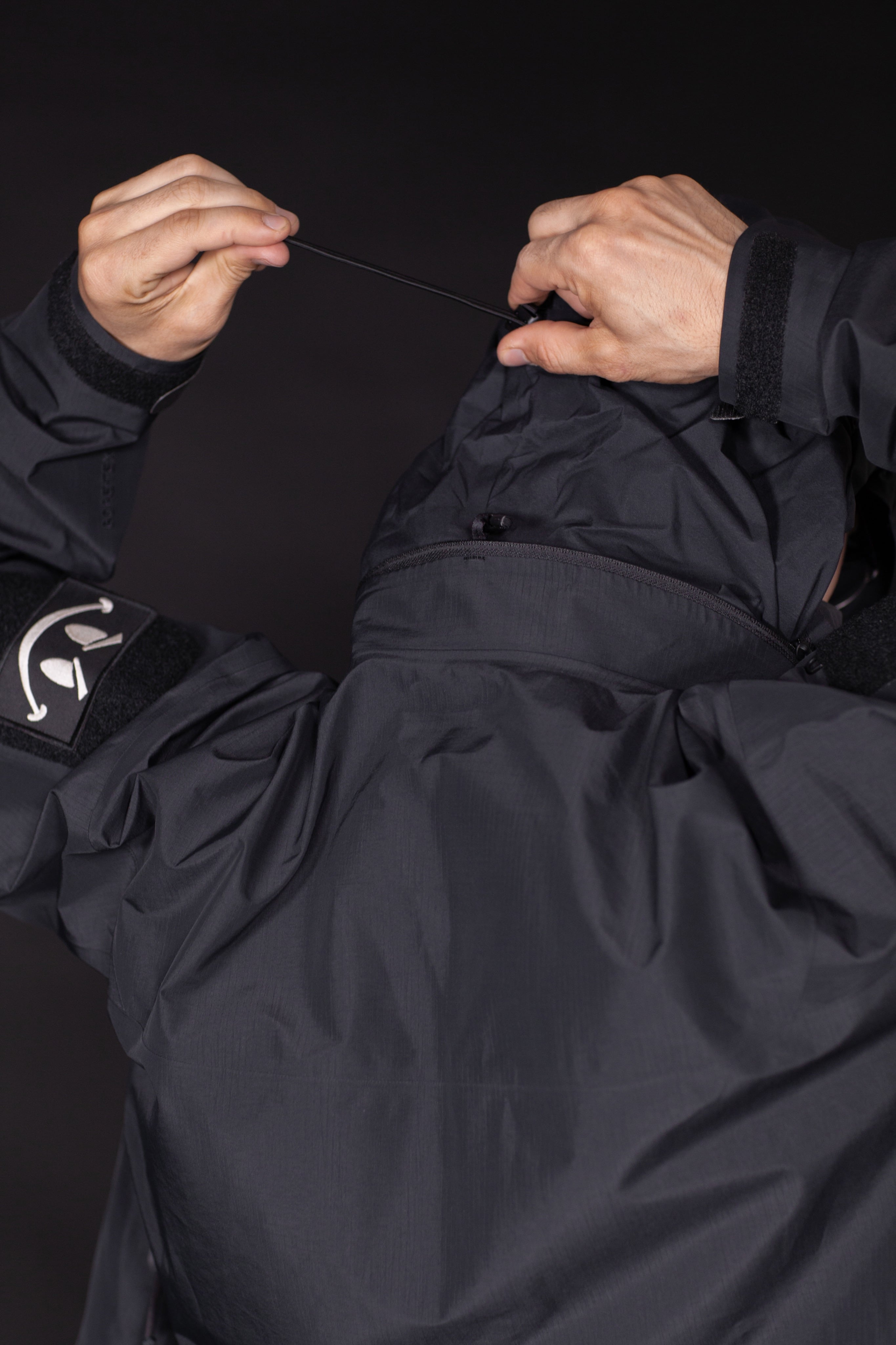
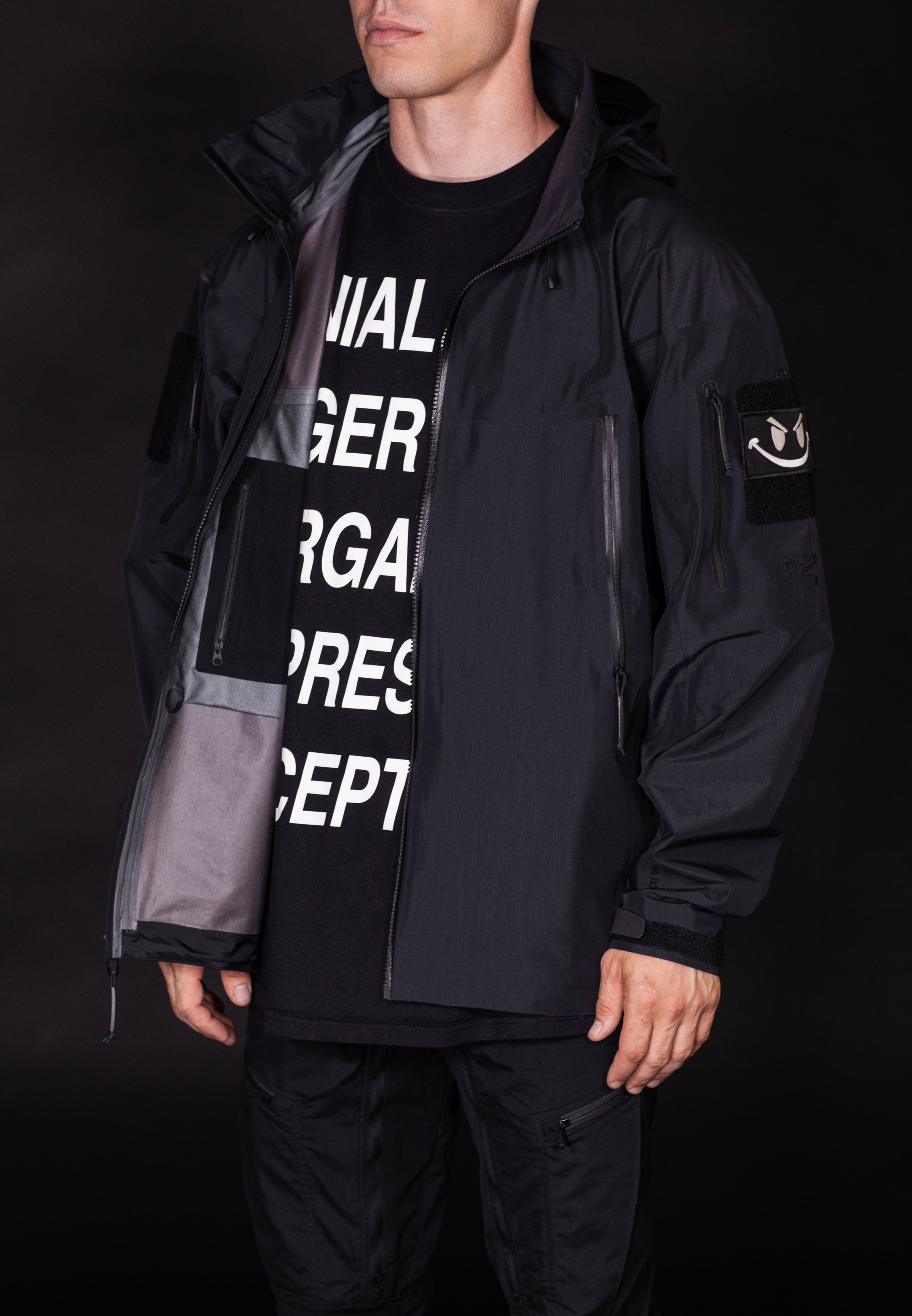
Arc’teryx
Arc’teryx is a Canadian company founded in 1989, when it initially focused on rock climbing gear. It has since expanded to tackle all kinds of outdoor markets and military equipment. While describing the garments created by Arc’teryx, I’m continually compelled to use the German word “fein” – which translates in English not to “fine” as in “ok,” but to the “fine” that really evokes the idea of craftsmanship, attention to detail, and elegance. It wasn’t easy for me to get my hands on LEAF (Law Enforcement and Armed Forces) equipment for this review – like Crye, Arc’teryx is not really interested in promoting this outside of dedicated user groups – but with a few calls and some reassurance, I did.
LEAF Alpha Jacket LT
The LEAF Alpha Jacket LT is expensive – even with a military discount – but seems worth every penny. Compared to the other jackets I have from Arc’teryx, this one stands out to me for its use of materials and its classiness. For something so lightweight, it feels very solid, with a hard shell made from top-of-the-line Gore-Tex materials. The fabric is “ripstop”: woven using a special reinforcing technique whereby thick reinforcement threads are interwoven in a crosshatch pattern. This is one of those details that adds not only value to the garment, but also a fine aesthetic detail. I haven’t attempted to crawl through rocky terrain or wrestle anyone in it, but presumably it would hold up.
The material used in the LEAF Alpha Jacket LT feels like some type of paper. If I had one criticism I would encourage Gore to develop a softer material with the same properties – which I’m sure isn’t easy, or something that they haven’t already considered. The arms have the typical military detail of a Velcro spot where you can attach some kind of identifying patch. I actually love this detail and take the chance to personalize the jacket with some funny Velcro patches I got on Amazon.
I imagine the main character in the William Gibson novel Pattern Recognition, who was always obsessing about rare and unbranded “ideal” clothing – like the perfect bomber jacket – would be compelled to pick up this jacket as well. There’s a streamlining, a flensing to this garment that comes from the fact that the end-user is not going anywhere where people are watching them for their clothes.
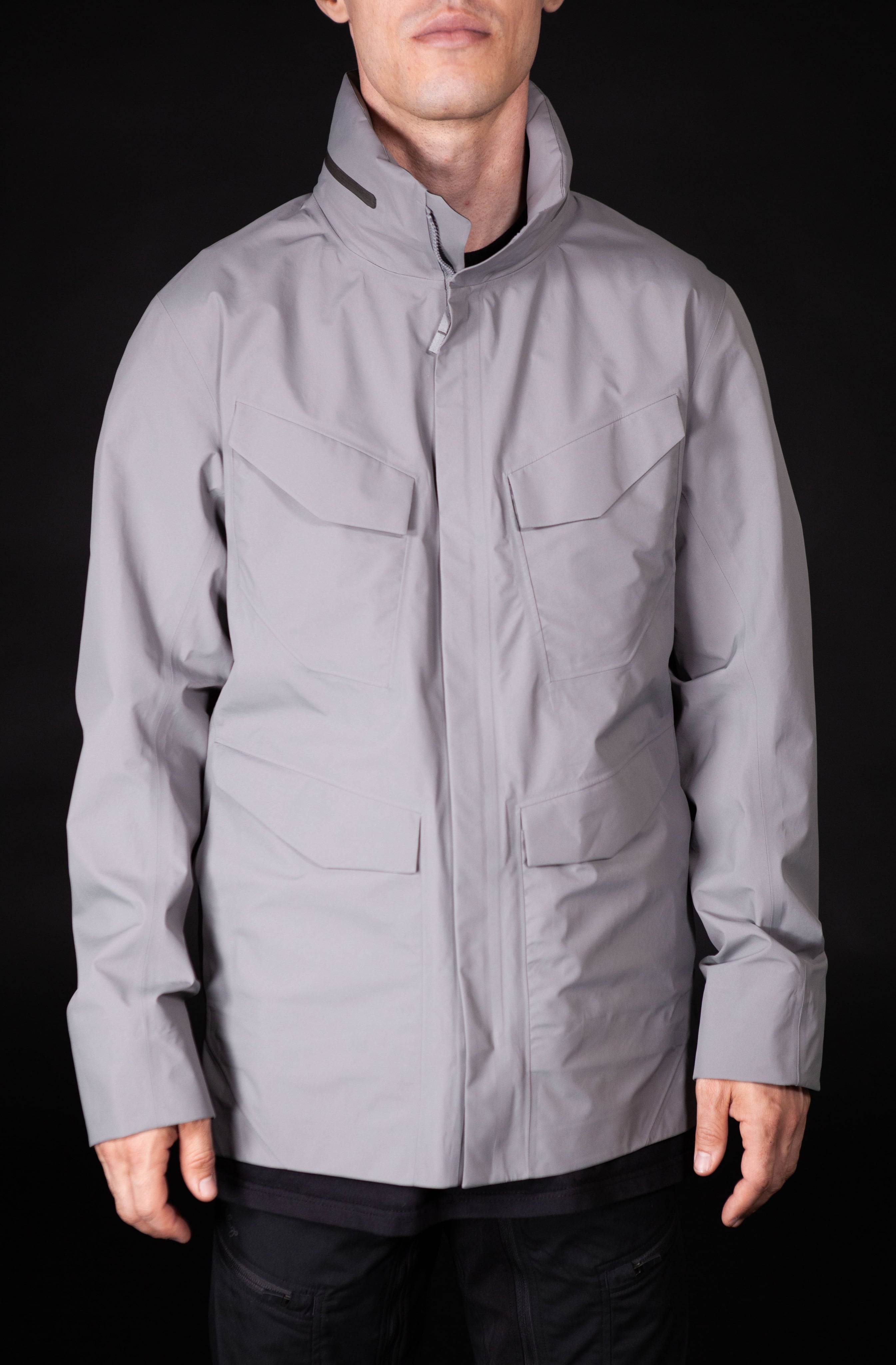
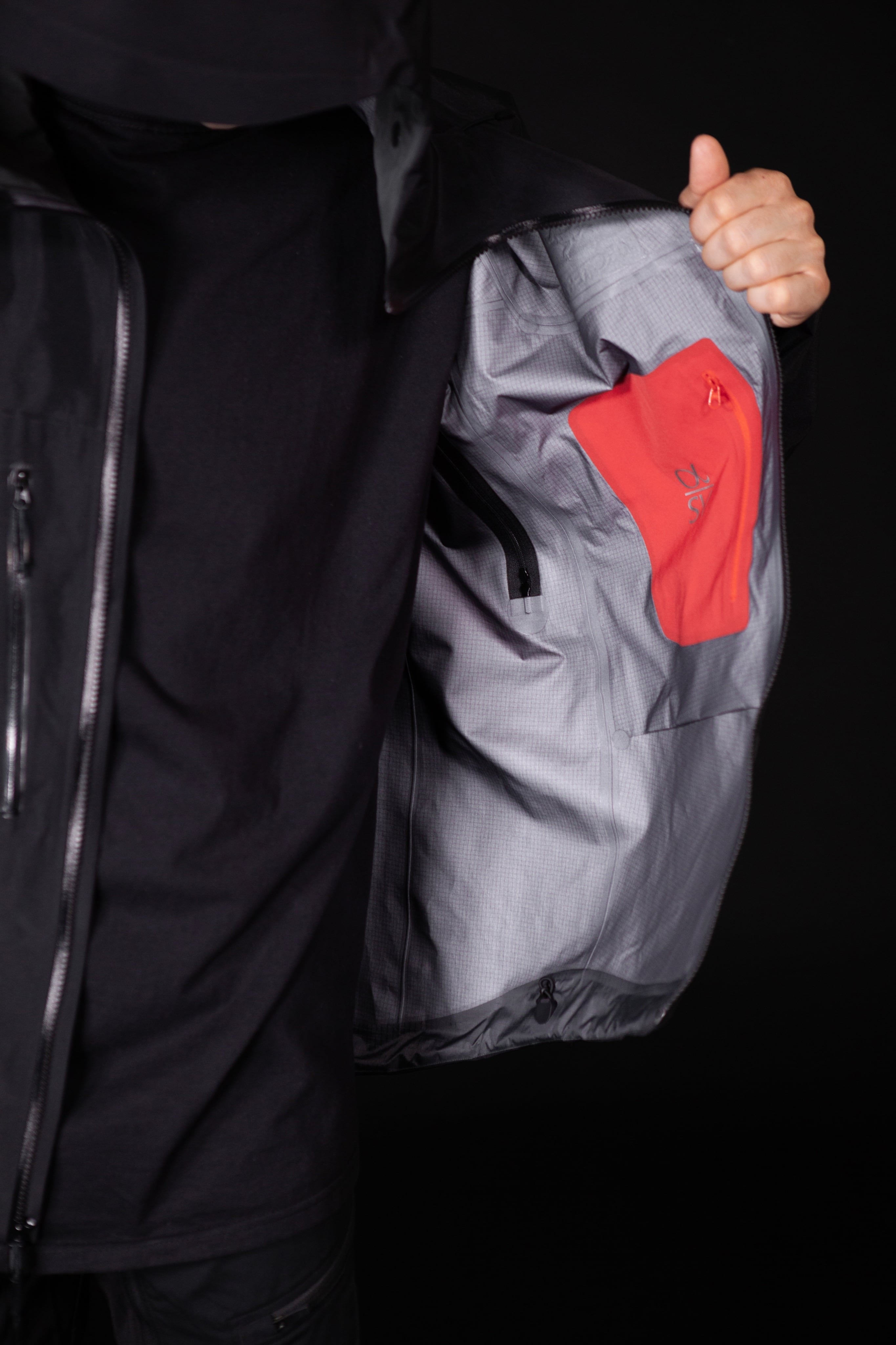
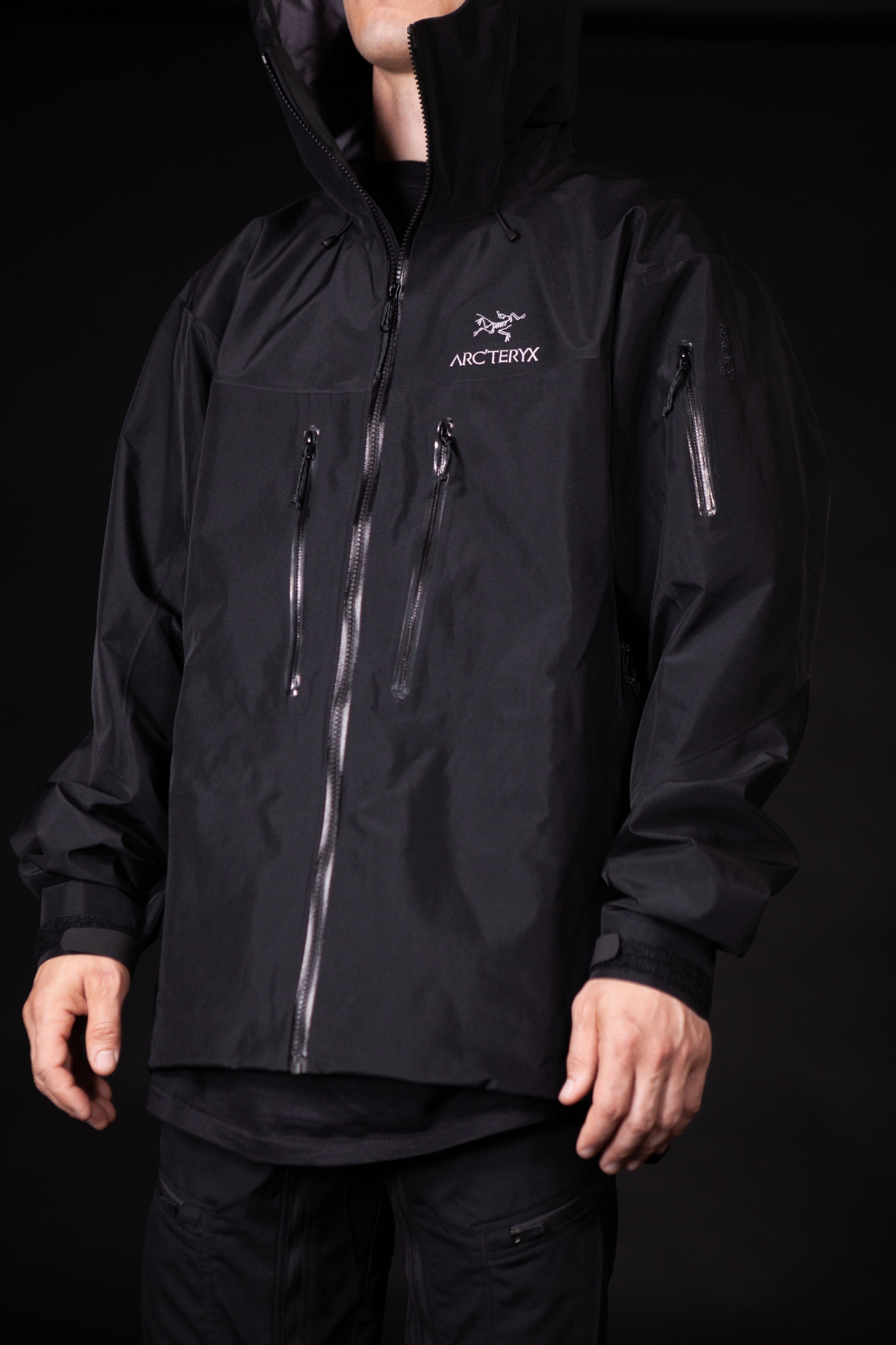
VEILANCE Field LT and Alpha SV Jacket
I was also able to compare the LEAF Alpha LT to two other jackets in the Arc’teryx family: the Field LT from Veilance, which is Arc’teryx’s “fashion” line, and the Alpha SV from the Arc’teryx original mountaineering line. Comparing all three, I would rank the Alpha SV as number two and the Field LT as a distant third. Both non-LEAF products are excellent items, and still highly recommended, but if we are at the Olympics of outerwear, there are winners and losers, no matter how impressive they may be compared to the rest of the field. The Field LT is a jacket for a designer who rides their bike to work, and probably for many end-users it’s completely dreamy. But for me Veilance’s attempt to take a fashionable tactical jacket backfires and we end up with a garment that sacrifices key functional attributes in pursuit of questionable aesthetics. The best work by Arc’teryx is a marriage of both form and function.
Arc’teryx has attempted to translate its core values of quality, durability, performance, and style into products targeting three distinct markets: military operators, mountaineers, and the urban elite. The Alpha SV, as the name implies, is very similar to the Alpha LT, but with a few key differences, albeit 95% of them cosmetic. The weatherproofing on the zippers is shiny. The logo is white and appears right on the chest. I’m not interested in wearing logos. The inside of the jacket has bright red pockets, which for me is unnecessary and inelegant. The pockets also don’t seem quite as durable as the ones on the LEAF model. The Veilence jacket came to me in a smaller size, M, and in a light grey. I only like black and oversized clothes, which might have colored my response a little. The sleeves on the Field don’t have a Velcro closure at the wrist; instead, they have an inset elastic cuff. This creates a visually simpler cuff – which is, I guess, more like that of a tailored garment, yet to me it looks a bit annoying and unfinished. The jacket also has some signature asymmetrically cut chest pockets that echo the traditional chest pockets of a military field shirt. But they don’t have zippers or Velcro! For me, it’s very important that the things I stick in my jacket – usually essentials like my keys, wallet, phone, etc. – are definitely not going to fall out. What’s the chance of that actually happening on this jacket? Ok, it’s low, but compared to a sealable pocket that makes for essentially zero risk? I wouldn’t take the chance.
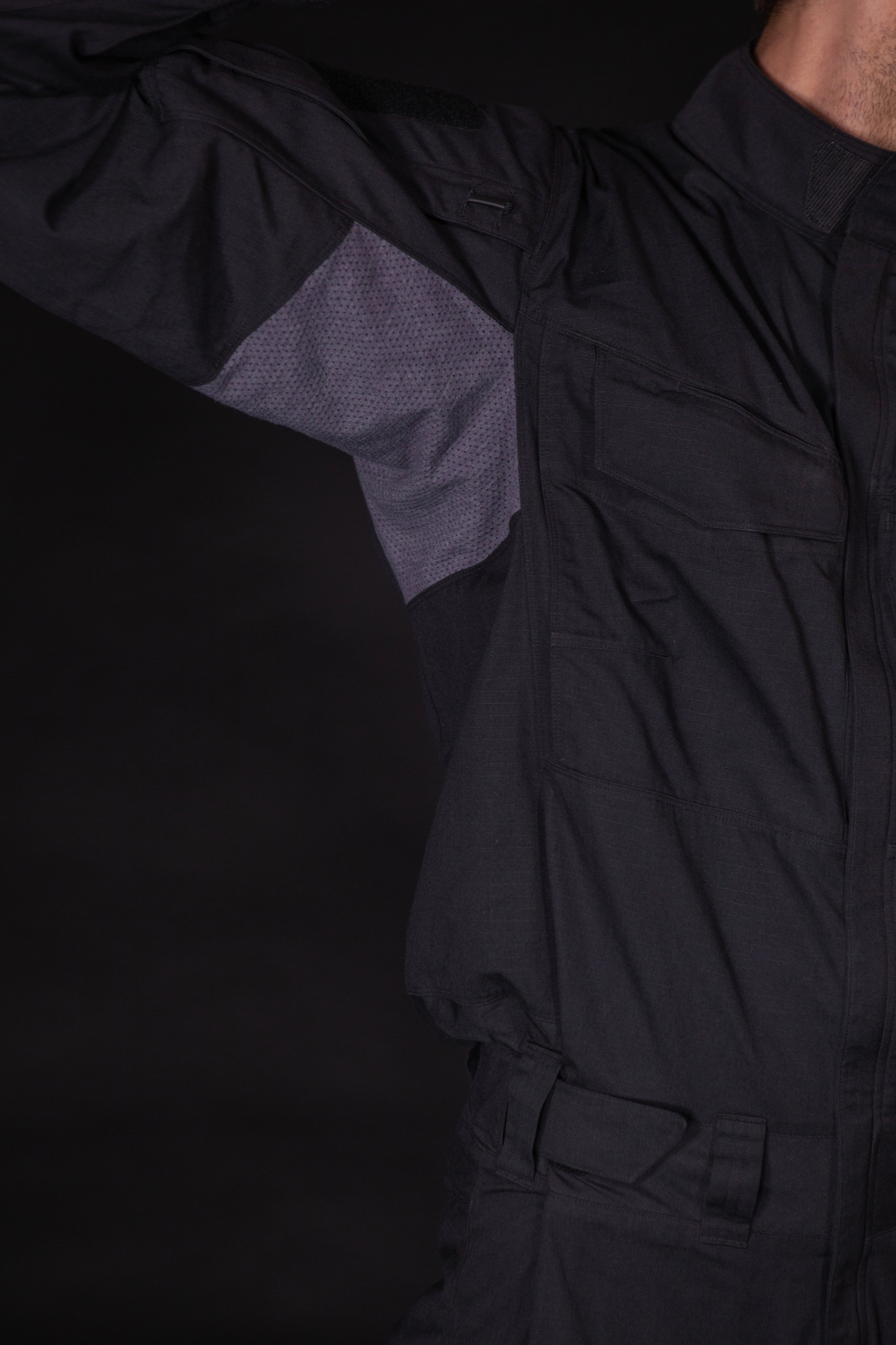
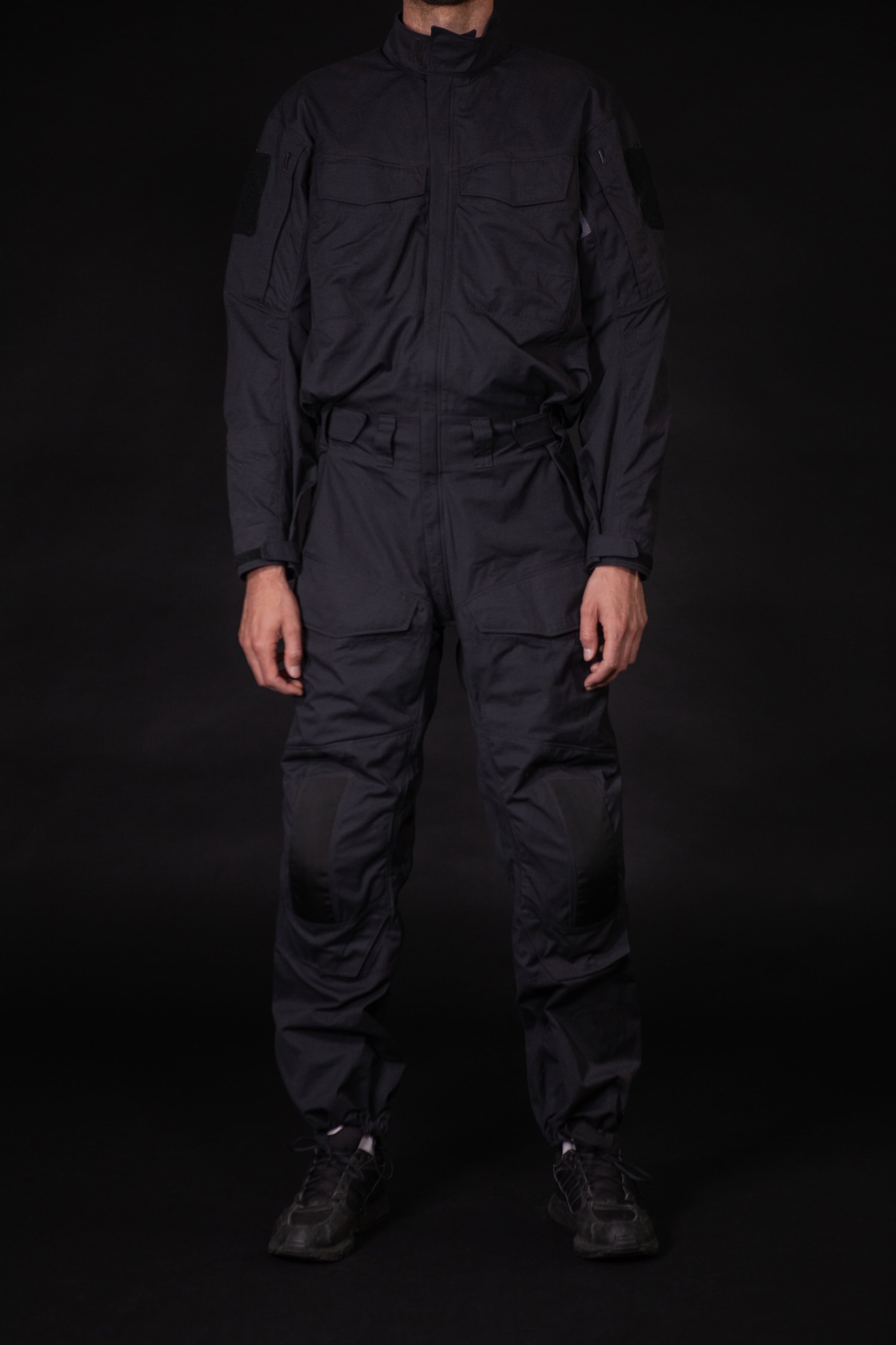
LEAF Assault Coverall AR
There is something radical and simple about a coverall. I love the feeling of wearing one because of the freedom of movement it gives to the hips. The Assault Coverall AR is an item from Arc’teryx LEAF that I’ve been curious about for a long time. Now that I finally have my hands on one, I’m not disappointed. The piece is made from a ripstop fabric suited to second-layer garments, and sits somewhere between biker gear, worker gear, and astronaut gear. People who saw me wearing it could feel that it was designed for tactical applications. I got “ninja-suit” a few times as a reaction.
The coverall moves excellently: open hips, easy shoulders, and good adjustability on the Velcro at the waist, ankles, and wrists. Ventilation fabric under the arms helps with the heat. The garment also features removable elbow and knee pads, which are really fun. I felt free to dive directly onto the concrete and do rolls without worrying about banging any sensitive joints. This item is comfortable, too, and there is always something sexy about a person in a one piece.
The Assault Coverall AR is a moderate weight garment – I wouldn’t call it light, but it’s definitely not heavy either. The design of the pockets on the upper thigh and chest is really slick and streamlined, with a nice asymmetric flap design and laser-cut Velcro to hold them closed. Whether it’s in the shape of the pockets, or the lines of the seams, this garment is beautifully well-considered. The construction around the torso looks cool and creates an almost insect-like hollowing around the abdomen in certain positions.
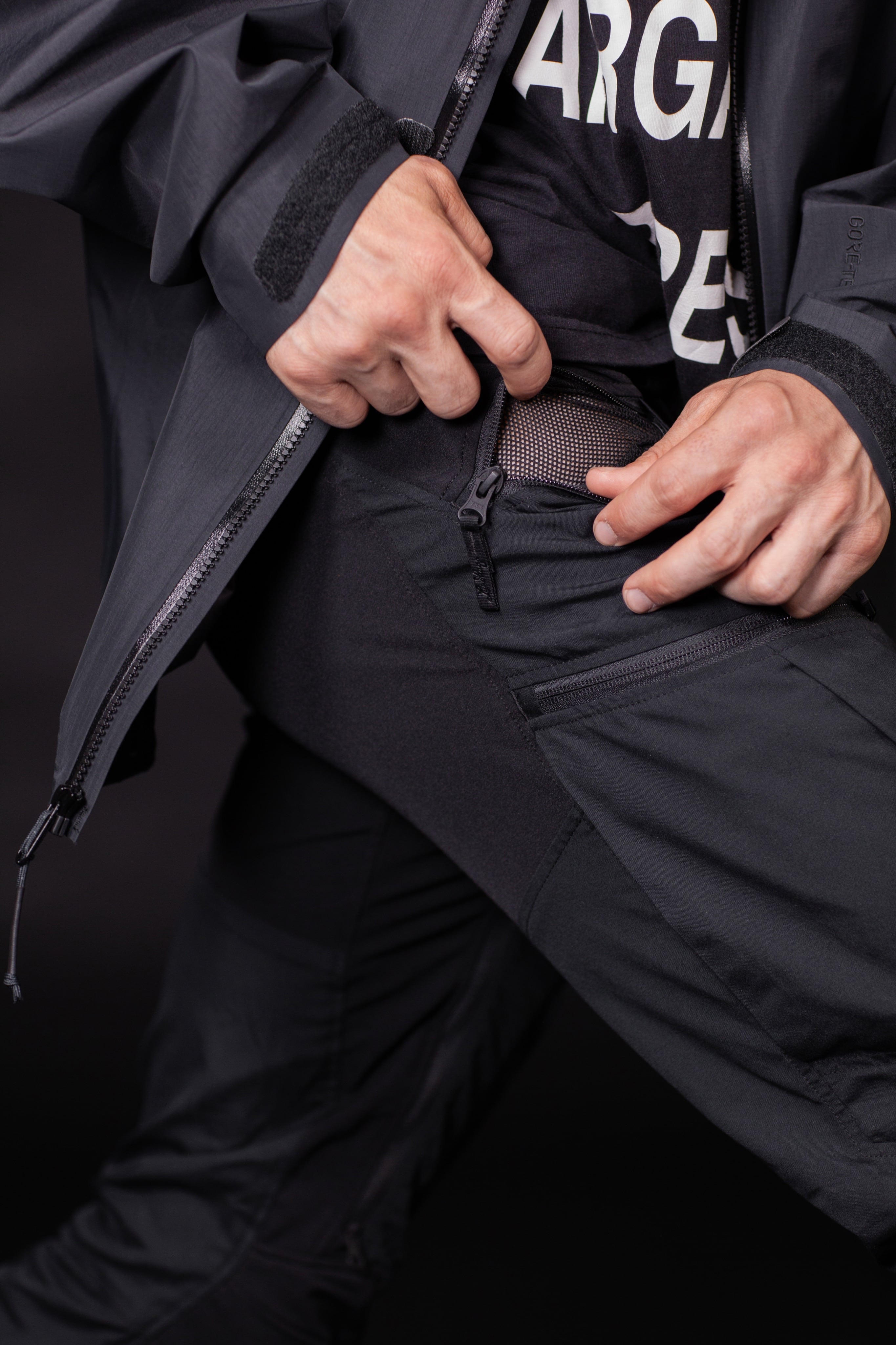
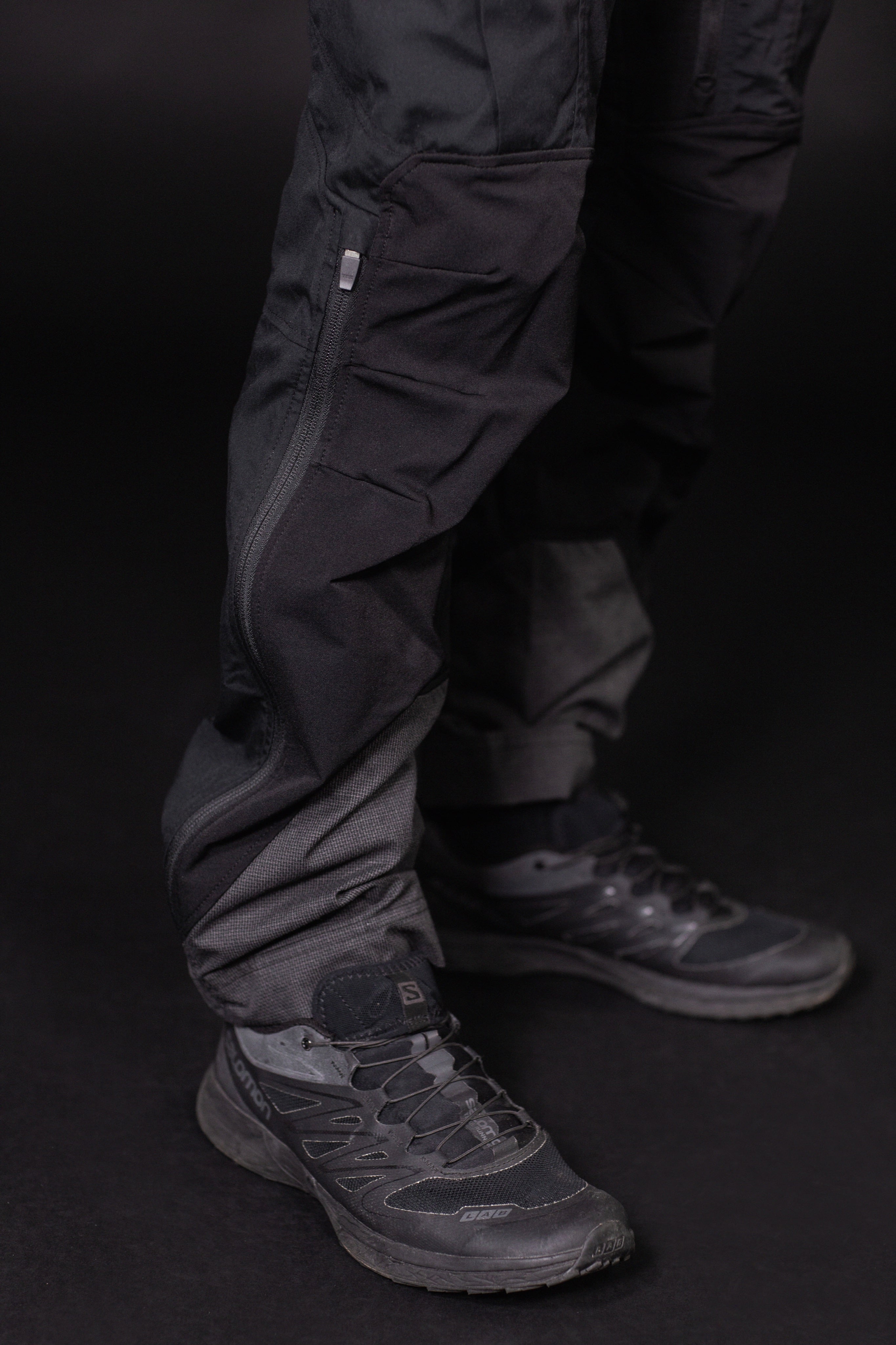
Lundhags
Lundhags is a small Swedish company with products that have been tested extensively in the Scandinavian outdoors. They started out in 1932, making boots that would last a lifetime, and have since expanded into other types of outdoor gear. Their stated goal is to develop equipment that delivers the ultimate in function and durability.
Makke MS Pants
The Makke MS Pants are a lightweight trekking pant. They have a clever mix of stretch, non-stretch, and specially reinforced material. They are incredibly well-fitting and easy to move in. I might even call them hiking cargo-leggings. They have a lot of zippers and pockets, which at first might not seem comfortable to pack gear into or move around in, but due to the stretch material at the seat and the knee, and the well-designed tailoring, the pants are actually very practical. I posted a picture of this item on my Instagram and I got a positive reaction from artists, fashion designers, and stylists. I wore these pants around in the summer and they do get a bit warm – but due to all the venting options in the upper thigh, inner thigh, and around the ankle it’s quite possible to regulate the temperature successfully.
I can drop into a full squat, slide into the splits, and sprint in these pants without any feeling of restriction. They are pretty low waisted, which actually reminds me a little of the fit of a lot of Acne jeans. I don’t love the effect visually, but it is good for moving. They have single stitch seams, but the materials from Schoeller – one of the best companies in the world for technical fabric – are sure to stand up to a lot of hardcore use. Each zipper has its own hood to contain the zip-pull when it’s closed, and each zipper area also has a slightly different zipper. If I could change anything, it would be to see narrower stitching on some of the seams and possibly smaller or lighter zippers.
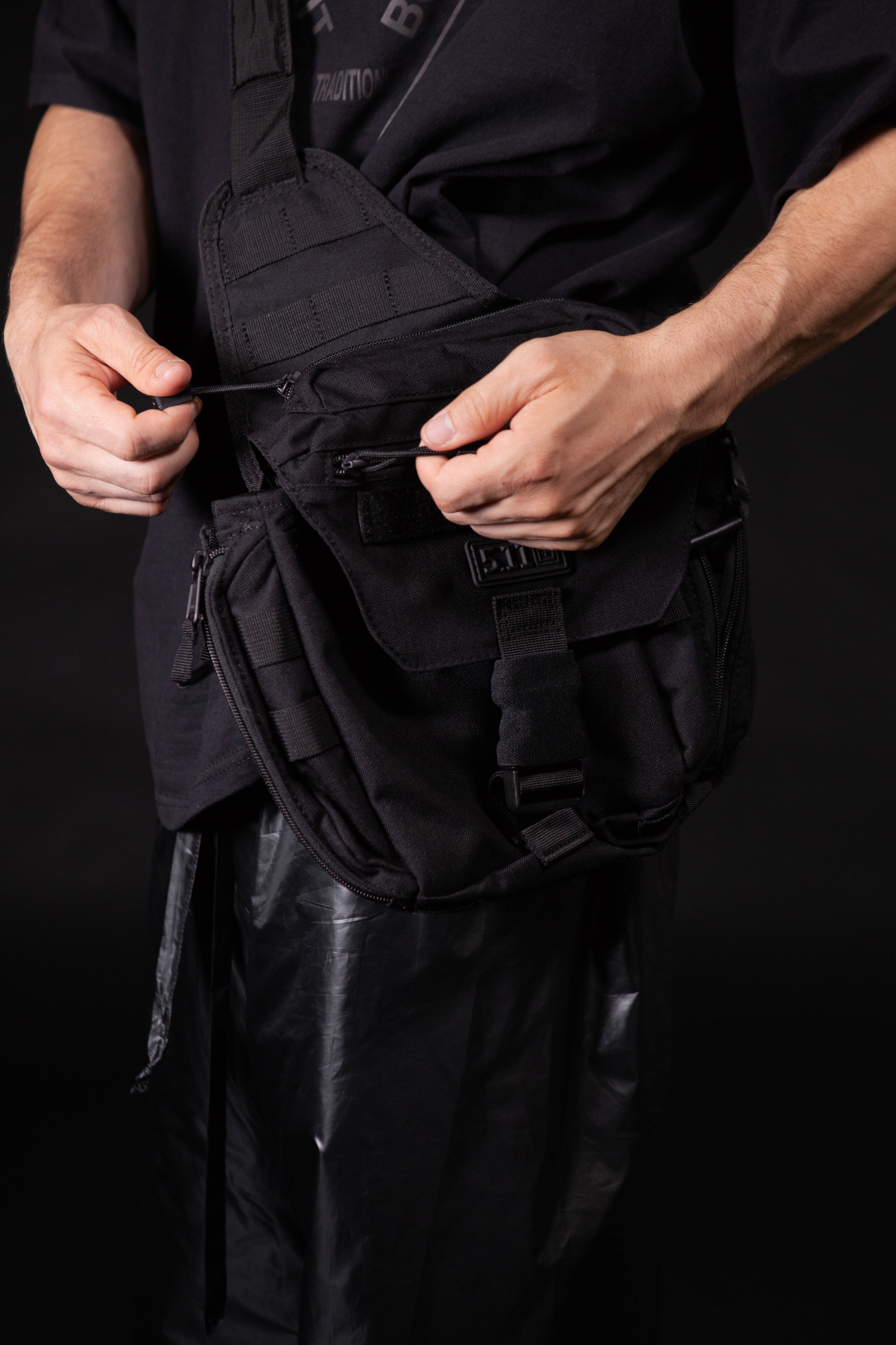
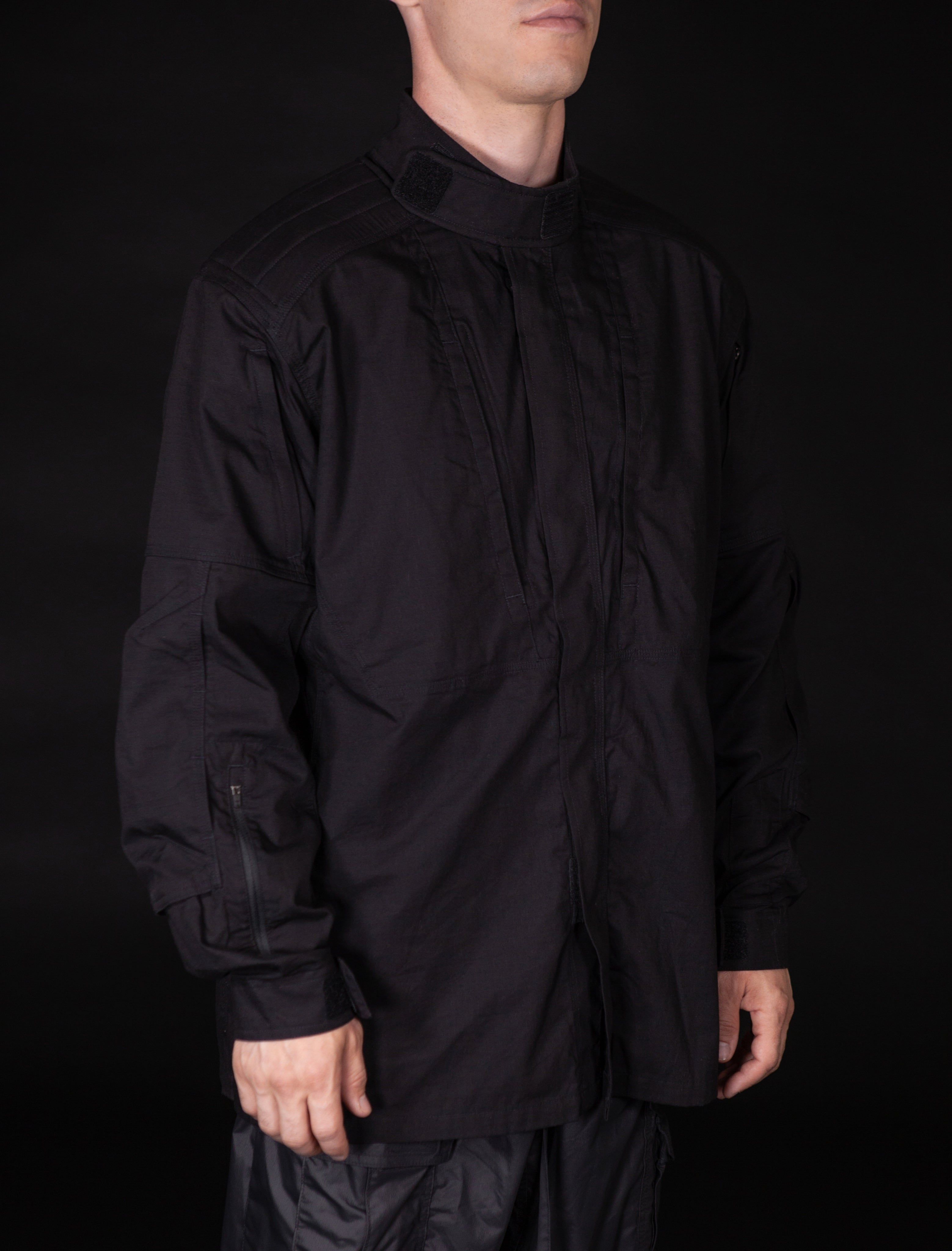
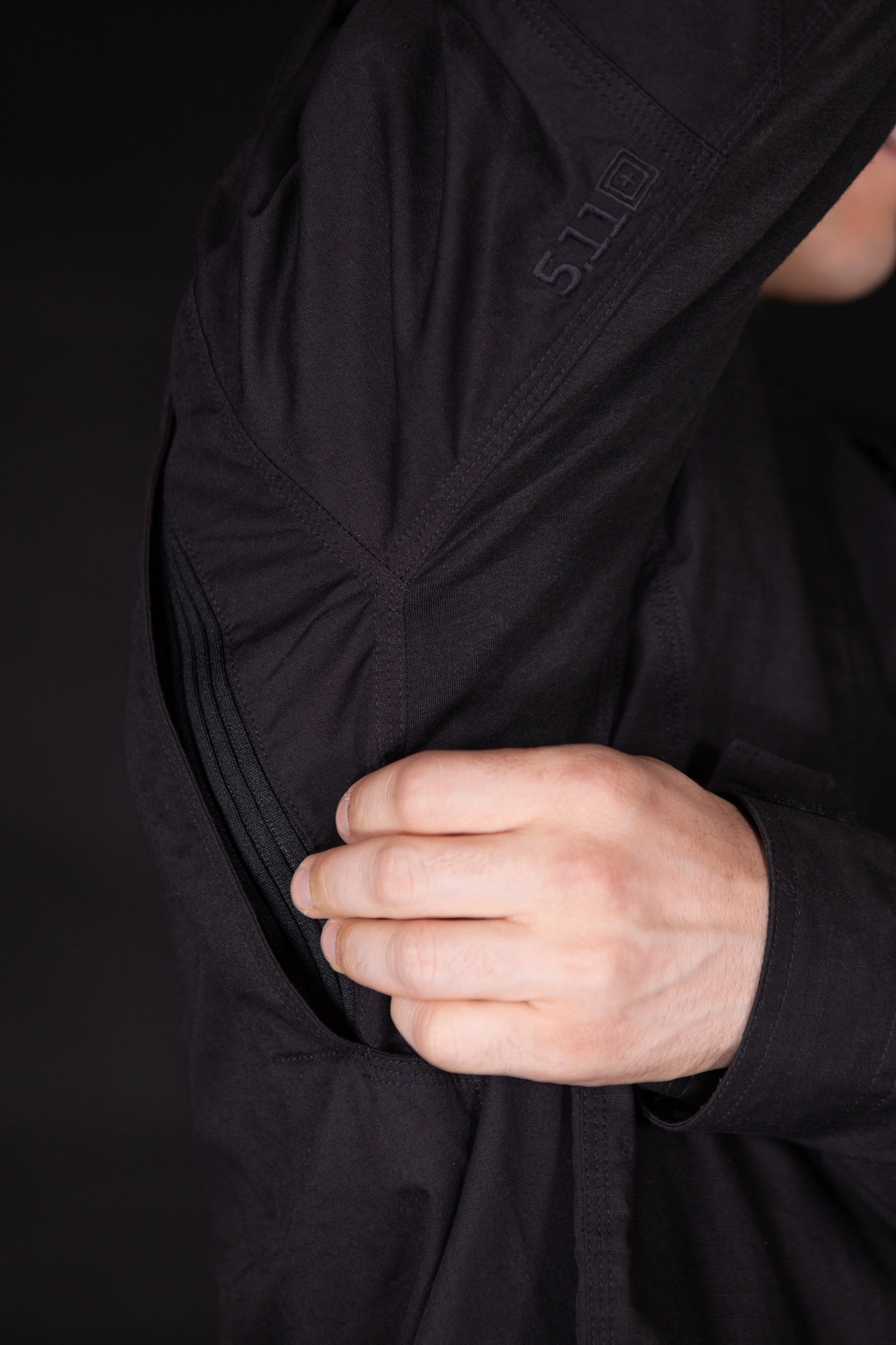
5.11 Tactical
5.11 Tactical was founded in the 1960s in California by climber Royal Robbins. After some changes of ownership and iterations, 5.11 Tactical eventually emerged in 2003 as a company specialized in producing uniforms and tactical equipment for military, law enforcement, and public safety personnel. I’ve come across 5.11 many times while researching affordable tactical gear. They make high quality stuff that is usually priced fairly. This year they are supplying weighted vests for the Cross-Fit Games. They also produced a limited edition Tactical Kilt, which is hard to find now and is super cool. The company caters to a range of consumer markets, with its higher end XPRT line in addition to its collections of “tactical dad” type polo shirts and pants with functional details.
PUSH Pack
This bag is designed for carriage on the left side of the body. It has space for a concealed pistol, and abundant pockets. The bag is kind of clunky, but it does have an option for securing it to a belt, which is cool. It has a good amount of padded zones designed to add comfort where the bag sits against the body. In terms of construction, though, somehow the product is just not that streamlined. There is a nice detail of a fabric slip cover that goes over the main buckle, but that feature also makes it a little annoying to open and close quickly, because you need to make sure the slip doesn’t get tangled up in the buckle when re-closing. The bag has a lot of pockets, and I like to have fewer pockets so I don’t get confused about where my stuff is. But that might just be a matter of personal preference – if I had to carry a lot of small things this feature might be useful.
XPRT® Tactical Long Sleeve Shirt
This shirt is from the XPRT line, which means it features a nice combination of strong and technical materials – Cordura, Teflon, Aramid, and Ortholite – and a crazy amount of reinforcing on the seams. It also has a cool, accordion-like ribbed material used to create venting in the armpit area. The shoulder pads actually got in the way a little bit when I raised my arms, but I’m sure that if I was wearing body armor and carrying a pack, I would be glad they were there. The chest pockets are well designed and easy to reach into. The collar reflects 5.11’s classic Tactical Shirt design: it’s kind of a mock turtleneck with a strap that can either go across the zipper or fold back on itself, and Velcro that stays closed and out of the way when the collar isn’t zipped to the top. This is the only item I reviewed that had an orgy of triple-stitched seams and bar-tack everywhere. If you’ve ever tried to make clothes, you know that not only do factories hate doing that much work, but it adds a surprising cost to the final garment. 5.11 pulls it off quite smoothly in this shirt.

Stryke™ TDU® Long Sleeve Shirt
The Stryke™ TDU® Long Sleeve Shirt doesn’t have as many integrated patented materials as the XPRT, but it’s strong, affordable, and most importantly available in MultiCam. It feels like a standard-issue garment in the best possible way. Although it still has a lot of strong stitching and attention to detail, in terms of construction it doesn’t quite hold its own against the other shirt. The front zippers’ color doesn’t match the MultiCam very well.
Beneath any discussion of tactical gear lies the question of the use of camouflage – always a loaded topic. Tactical clothing is designed to be worn by people engaged in the business of controlling other people. In a fashion context, it’s often worn by fans of hard music like punk, gabber, and metal. For many, camo is an aggressive, sinister pattern that evokes the environment in which it is most often used: conflict zones. While I was wearing the Crye backpack, some observers told me it was a bit “scary” – perhaps because it doesn’t look like “fashion” camo, but rather like something used by an actual soldier. Personally, I think the pattern has an undeniable beauty. Its chaotic, nature-inspired colors and shapes are designed to blend into plants, trees, rocks, and bushes – a texture and color palette that is scarce in urban environments, and sorely missed by many contemporary city dwellers. This article features many items in MultiCam, which is simultaneously the most effective camo according to US Army testing and, in my opinion, the most beautiful one ever created. Camo is of course super popular in streetwear, probably for reasons similar to why punks like combat boots: there is something aggressive about the pattern, but by wearing it the user performs kind of counter-twist action – a derailing of the intended function that also acts as a criticism of the system that produces it.
Nik Kosmas is an artist, personal trainer and designer based in Berlin.
Credits
- Text: Nik Kosmas
- Photography: Iga Drobisz
